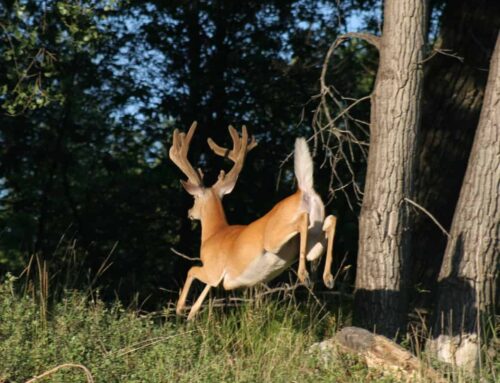 There are few among our BIG DEER army who would shoot a button fawn buck on purpose, but every one of us has accidentally done it. We have an antlerless tag and drop a fat “doe” to fill the freezer…we walk up to the deer and go, “Uh, oh,” as we see its nubs and male parts.
There are few among our BIG DEER army who would shoot a button fawn buck on purpose, but every one of us has accidentally done it. We have an antlerless tag and drop a fat “doe” to fill the freezer…we walk up to the deer and go, “Uh, oh,” as we see its nubs and male parts.
It’s an honest mistake that anybody can make, and that’s why harvesting a young buck with less than 2” of antler is legal in most states (check your regulations).
But you obviously never want to shoot a button. These pointers from the Michigan DNR will help you differentiate an adult doe from a buck fawn, so you won’t mess up again.
–Check body shape. A mature doe’s body is rectangular, with a long neck and face. A buck fawn is square-shaped and has a short neck and face.
Study heads with binoculars. A doe’s head is normally more rounded on top between the ears, and a buck’s head is flattened near the base of the antlers.Obviously look for little nubs too as you glass.
–If you spot a single deer ambling around looking lost consider this: Button bucks are often alone, while adult does tend to travel with other deer. But plenty of does walk around alone too.
–If possible, wait until 3 or more antlerless deer are together (maybe feeding out in a plot) then after glassing, harvest one of the larger animals.
–If two juvenile deer are alone without an adult doe, one will probably be a button buck. Normally the young male is larger than the female and could be mistaken for an adult doe. Look closely with binoculars for the antler bases and nubs of a button buck.
–Wait until the deer are standing or moving slowly. It is easier to identify sex and age when deer are not moving too fast.
–Shoot with good visibility. Poor light and heavy cover make it difficult if not impossible to determine a deer’s sex and age.






There’s another equation to consider as well. Where deer numbers are low such as many parts of Pa., if you want to eat venison but have not had luck with tagging an altered deer harvest the button buck an let the mature doe drop her fawns next spring.